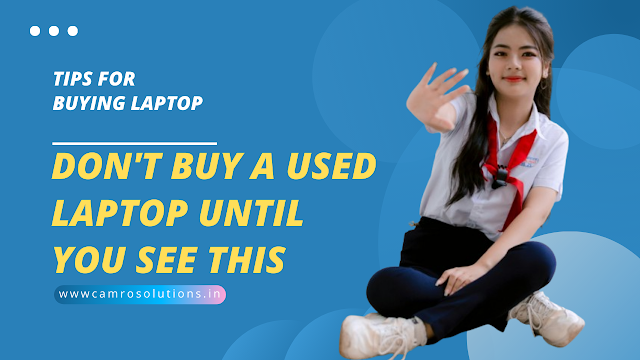✅ What to Consider Before Buying a Refurbished or Used Laptop
1. 🔍 Understand the Difference Between Refurbished and Used
Before diving into the buying process, it's essential to know the difference:
-
Refurbished Laptop: This is a pre-owned laptop that has been inspected, repaired, cleaned, and tested by professionals. It is usually sold by manufacturers or certified refurbishers and often comes with a warranty.
-
Used Laptop: This is sold as-is by individual users, without professional inspection or warranty. It may work fine but carries more risk.
If you want peace of mind, always go for a certified refurbished laptop instead of a random used one.
2. 🏪 Choose a Reputable Seller
Where you buy the laptop matters. Always choose trusted platforms like:
-
Official manufacturer outlets (like Dell Outlet, HP Renew, Apple Certified Refurbished)
-
Certified refurbishers (like Amazon Renewed, Flipkart Refurbished)
-
Reputed local computer stores
-
Avoid shady websites or individual sellers without proper reviews or buyer protection.
Always read customer reviews and check seller ratings before placing your order.
3. 💻 Check Laptop Specifications
Before buying a second-hand or refurbished laptop, make sure it meets your needs. Check the following specs:
-
Processor: Intel i5/i7 or AMD Ryzen 5/7 (avoid very old models like Core 2 Duo or 1st-gen CPUs)
-
RAM: At least 8GB for multitasking (4GB is minimal for basic use)
-
Storage: SSD is preferred over HDD for faster speed. At least 256GB SSD is ideal.
-
Display: A full HD (1920x1080) screen is much better than a lower resolution display.
-
Graphics: If you’re into gaming or designing, make sure it has a dedicated GPU.
Old specs can cause lag and compatibility issues with new software and updates.
4. 🔋 Check the Battery Health
Laptop batteries naturally degrade over time. If you're buying a used laptop, the battery may not last long. Ask the seller for:
-
Battery cycle count (lower is better)
-
Battery health status
-
Whether the battery needs replacement soon
If you're buying locally, test how long the battery lasts. If it dies within 30–60 minutes, consider negotiating a discount or planning for a replacement.
5. 🖥️ Inspect Physical Condition Thoroughly
Don't just look at the screen and keyboard. Inspect the laptop body carefully for:
-
Cracks or dents on the body
-
Loose or broken hinges
-
Dead pixels or screen discoloration
-
Faulty keys or non-functional touchpad
-
Damaged USB ports or headphone jacks
Cosmetic wear is okay, but hardware damage could affect usability.
6. 🧪 Test All Functional Components
When possible, test the following:
-
Wi-Fi and Bluetooth connectivity
-
Keyboard and touchpad
-
Webcam and microphone
-
Speakers and headphone jack
-
All ports (USB, HDMI, etc.)
This ensures you won’t face surprise issues after buying.
7. 🛡️ Verify the Operating System and Software
Always confirm whether the laptop has a genuine operating system:
-
Check for Windows license activation under Settings > System > Activation
-
If it's a Mac, ensure the macOS version is genuine and not tampered
-
Avoid laptops with pirated software—it’s illegal and risky
Also, ask if it comes with any useful pre-installed software or antivirus.
8. 📄 Look for Warranty or Return Policy
Most refurbished laptops come with at least 3 to 12 months warranty. This gives you confidence in the quality. If there’s no warranty, ensure the seller offers at least a 7-day return window.
If you're buying directly from an individual, get a written agreement or bill for your protection.
9. 💰 Compare Prices and Negotiate
Always compare the price of the used or refurbished laptop with a new model. Sometimes the price difference isn’t worth the risk, especially if the used one is too old.
Don’t hesitate to negotiate the price if the laptop is missing accessories or has minor issues.
10. 📦 Check for Accessories and Inclusions
Ask if the laptop comes with:
-
Original charger and power adapter
-
Laptop bag or sleeve
-
Additional accessories like a mouse, external keyboard, or software
If the charger is not original or working well, it can be an additional expense.
Conclusion
Buying a refurbished or used laptop can be a smart and economical decision—but only if you’re careful. Always research the seller, inspect the laptop thoroughly, and verify specifications. With the right steps, you can get a great device without breaking the bank.

Post a Comment